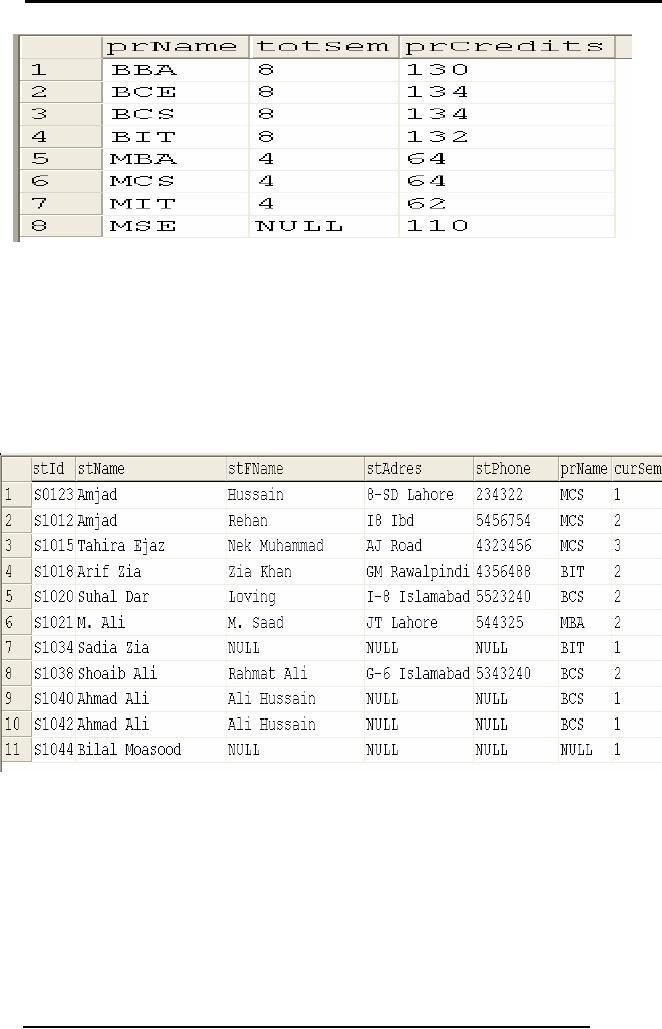 |

Database
Management System
(CS403)
VU
Lecture No.
41
Reading
Material
"Database
Systems Principles, Design
and Implementation" written by
Catherine Ricardo,
Maxwell
Macmillan.
"Database
Management System" by Jeffery A
Hoffer
Overview of
Lecture
o Indexes
o Index
Classification
In our
previous lecture we were discussing
the views. Views play an
important role in
database.
At this layer database is
available to the users. The
user needs to know
that
they
are dealing with views; it
is infact virtual for them.
It can be used to
implement
security.
We were discussing dynamic views
whose data is not stored as
such.
Updating
Multiple Tables
We can do
this updation of multiple
views by doing it one at a
time. It means that
while
inserting values in different
tables, it can only be done
one at a time. We will
now
see an example of this as
under:
CREATE VIEW
st_pr_view1 (a1, a2, a3,
a4) AS (select stId,
stName,
program.prName,
prcredits from student,
program WHERE student.prName =
program.prName)
In this
example this is a join
statement
We will
now enter data in the
table
insert
into st_pr_view1 (a3, a4)
values ('MSE', 110)
We will
now see the program
table after writing this
SQL statement as the
data
has
been stored in the
table.
Select *
from program
288

Database
Management System
(CS403)
VU
In this
example the total semester
is NULL as this attribute was
not defined in view
creation
statement, so then this value will
remain NULL. We will now see
another
example.
In this we have catered for
NOT NULL.
insert
into st_pr_view1 (a1, a2)
values (`S1043', `Bilal
Masood')
SELECT *
from student
Materialized
Views
A
pre-computed table comprising
aggregated or joined data from
fact and possibly
dimensions
tables. Also known as
summary or aggregate table.Views
are virtual
tables.
In which query is executed
every time .For complex
queries involving
large
number of
join rows and aggregate
functions, so it is problematic. Its
solution is
materialized
views also called indexed
views created through clustered
index.
Creating
a clustered index on a view
stores the result set
built at the time the
index is
created. An
indexed view also
automatically reflects modifications
made to the data in
289

Database
Management System
(CS403)
VU
the
base tables after the
index is created, the same
way an index created on a
base
table
does. Create indexes only on
views where the improved
speed in retrieving
results
outweighs the increased overhead of
making modifications.
Materialized
views are schema objects
that can be used to summarize,
compute,
replicate,
and distribute data. They
are suitable in various
computing environments
such as
data warehousing, decision support,
and distributed or mobile
computing:
In data
warehouses, materialized views are
used to compute and
store
�
aggregated
data such as sums and
averages. Materialized views in
these
environments
are typically referred to as summaries
because they store
summarized data.
They can also be used to
compute joins with or
without
aggregations.
If compatibility is set to
Oracle9i or
higher, then
materialized
views
can be used for queries
that include filter
selections.
Cost-based
optimization can use
materialized views to improve
query
performance
by automatically recognizing when a
materialized view can
and
should be
used to satisfy a request. The
optimizer transparently rewrites
the
request to
use the materialized view.
Queries are then directed to
the
materialized
view and not to the
underlying detail tables or
views.
In
distributed environments, materialized
views are used to replicate
data at
�
distributed
sites and synchronize updates
done at several sites with
conflict
resolution
methods. The materialized views as
replicas provide local
access to
data that
otherwise have to be accessed
from remote sites.
In mobile
computing environments, materialized
views are used to download
a
�
subset of
data from central servers to
mobile clients, with
periodic refreshes
from
the central servers and
propagation of updates by clients back to
the
central
servers.
Materialized
views are similar to indexes in
several ways:
They
consume storage space.
�
They must
be refreshed when the data in
their master tables
changes.
�
290

Database
Management System
(CS403)
VU
They
improve the performance of
SQL execution when they
are used for
�
query
rewrites.
Their
existence is transparent to SQL
applications and
users.
�
Unlike
indexes, materialized views
can be accessed directly
using a SELECT
statement.
Depending on the types of
refresh that are required,
they can also be
accessed
directly in an INSERT, UPDATE, or DELETE statement.
A
materialized view can be
partitioned. You can define
a materialized view on a
partitioned
table and one or more
indexes on the materialized
view.
Transaction
Management
A
transaction can be defined as an
indivisible unit of work
comprised of several
operations,
all or none of which must be
performed in order to preserve data
integrity.
For
example, a transfer of Rs 1000
from your checking account
to your savings
account
would consist of two steps:
debiting your checking account by
Rs1000 and
crediting
your savings account with
Rs1000. To protect data integrity
and consistency
and
the interests of the bank
and the customer these two
operations must be applied
together
or not at all. Thus, they
constitute a transaction.
Properties
of
a
transaction
All transactions
share these properties:
atomicity, consistency, isolation,
and
durability
(represented by the acronym
ACID).
Atomicity:
This implies indivisibility;
any indivisible operation
(one which
�
will
either complete fully or not
at all) is said to be atomic.
Consistency:
A transaction must transition persistent
data from one consistent
�
state to
another. If a failure occurs
during processing, the data must be
restored
to the
state it was in prior to the
transaction.
Isolation:
Transactions should not
affect each other. A
transaction in progress,
�
not
yet committed or rolled back
(these terms are explained at the
end of this
section),
must be isolated from other
transactions. Although
several
transactions
may run concurrently, it
should appear to each that
all the others
291

Database
Management System
(CS403)
VU
completed
before or after it; all
such concurrent transactions must
effectively
end in
sequential order.
Durability:
Once a transaction has successfully
committed, state
changes
�
committed
by that transaction must be durable
and persistent, despite
any
failures
that occur
afterwards.
A
transaction can thus end in
two ways: a commit, the
successful execution of
each
step in
the transaction, or a rollback,
which guarantees that none of
the steps are
executed
due to an error in one of those
steps.
292
Table of Contents:
- Introduction to Databases and Traditional File Processing Systems
- Advantages, Cost, Importance, Levels, Users of Database Systems
- Database Architecture: Level, Schema, Model, Conceptual or Logical View:
- Internal or Physical View of Schema, Data Independence, Funct ions of DBMS
- Database Development Process, Tools, Data Flow Diagrams, Types of DFD
- Data Flow Diagram, Data Dictionary, Database Design, Data Model
- Entity-Relationship Data Model, Classification of entity types, Attributes
- Attributes, The Keys
- Relationships:Types of Relationships in databases
- Dependencies, Enhancements in E-R Data Model. Super-type and Subtypes
- Inheritance Is, Super types and Subtypes, Constraints, Completeness Constraint, Disjointness Constraint, Subtype Discriminator
- Steps in the Study of system
- Conceptual, Logical Database Design, Relationships and Cardinalities in between Entities
- Relational Data Model, Mathematical Relations, Database Relations
- Database and Math Relations, Degree of a Relation
- Mapping Relationships, Binary, Unary Relationship, Data Manipulation Languages, Relational Algebra
- The Project Operator
- Types of Joins: Theta Join, Equi–Join, Natural Join, Outer Join, Semi Join
- Functional Dependency, Inference Rules, Normal Forms
- Second, Third Normal Form, Boyce - Codd Normal Form, Higher Normal Forms
- Normalization Summary, Example, Physical Database Design
- Physical Database Design: DESIGNING FIELDS, CODING AND COMPRESSION TECHNIQUES
- Physical Record and De-normalization, Partitioning
- Vertical Partitioning, Replication, MS SQL Server
- Rules of SQL Format, Data Types in SQL Server
- Categories of SQL Commands,
- Alter Table Statement
- Select Statement, Attribute Allias
- Data Manipulation Language
- ORDER BY Clause, Functions in SQL, GROUP BY Clause, HAVING Clause, Cartesian Product
- Inner Join, Outer Join, Semi Join, Self Join, Subquery,
- Application Programs, User Interface, Forms, Tips for User Friendly Interface
- Designing Input Form, Arranging Form, Adding Command Buttons
- Data Storage Concepts, Physical Storage Media, Memory Hierarchy
- File Organizations: Hashing Algorithm, Collision Handling
- Hashing, Hash Functions, Hashed Access Characteristics, Mapping functions, Open addressing
- Index Classification
- Ordered, Dense, Sparse, Multi-Level Indices, Clustered, Non-clustered Indexes
- Views, Data Independence, Security, Vertical and Horizontal Subset of a Table
- Materialized View, Simple Views, Complex View, Dynamic Views
- Updating Multiple Tables, Transaction Management
- Transactions and Schedules, Concurrent Execution, Serializability, Lock-Based Concurrency Control, Deadlocks
- Incremental Log with Deferred, Immediate Updates, Concurrency Control
- Serial Execution, Serializability, Locking, Inconsistent Analysis
- Locking Idea, DeadLock Handling, Deadlock Resolution, Timestamping rules